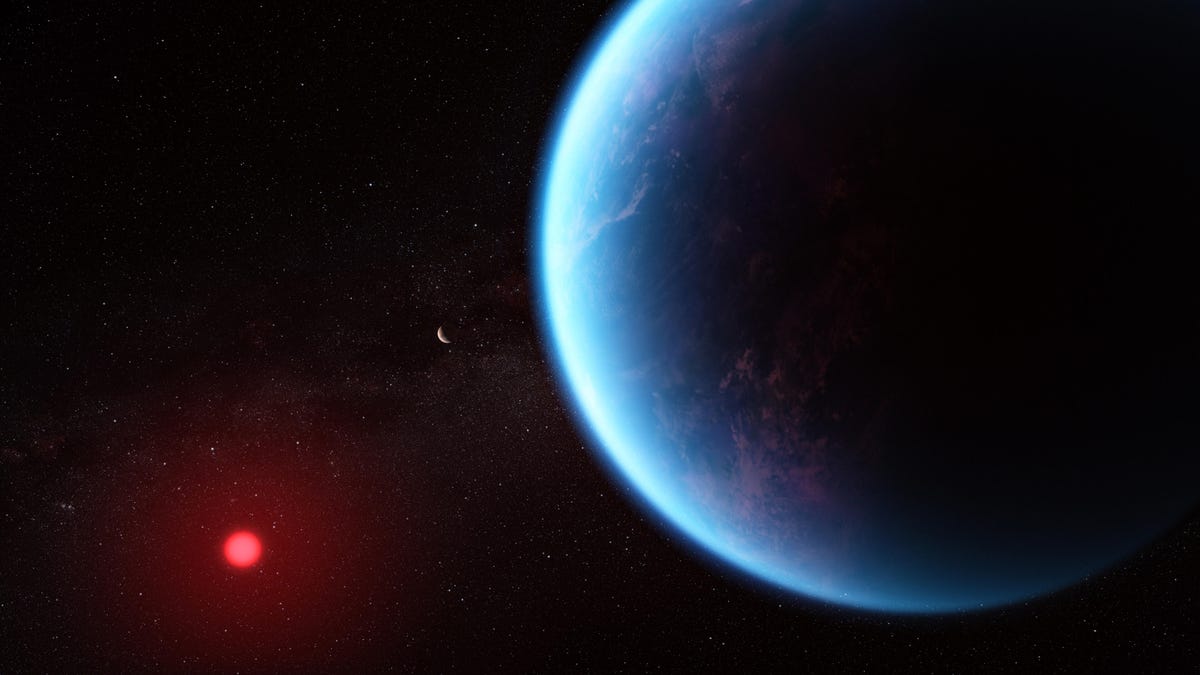Webb Finds Potentially Habitable Exoplanet Might Be an Ocean World
NASA's James Webb Space Telescope paints an enthralling picture of a planet that could be a prime place to look for evidence of life.

An illustration shows what exoplanet K2-18 b might look like in orbit around its star.
The next time you gaze at the Leo constellation, take a moment to contemplate K2-18 b, a fascinating planet there that has scientists wondering if it could harbor life. New data from the James Webb Space Telescope gives us a scintillating vision of an exoplanet that may be covered in a liquid water ocean.
K2-18 b gets its name from host star K2-18, which is located about 120 light-years from us. That's not terribly far in space terms, but we won't be popping over there for an in-person visit anytime soon. K2-18 b orbits in the habitable zone of its star, a region where liquid water could be present on the planet. The exoplanet may be what's known as a Hycean world, one that is covered in water with a hydrogen-rich atmosphere. The name is a combination of "hydrogen" and "ocean."
Astronomers from the University of Cambridge identified Hycean planets as a new class of habitable planet in 2021. The researchers encouraged investigating these worlds for biosignatures -- evidence of life -- as we continue our search for life beyond Earth.
"Traditionally, the search for life on exoplanets has focused primarily on smaller rocky planets, but the larger Hycean worlds are significantly more conducive to atmospheric observations," said University of Cambridge astronomer Nikku Madhusudhan, lead author of a paper on the Webb results (PDF). This is where Webb's powerful instruments come in.
Webb is building off observations made by the venerable Hubble Space Telescope. Hubble already discovered water vapor in the atmosphere of K2-18 b. Webb has now detected carbon-bearing molecules methane and carbon dioxide in K2-18 b's atmosphere. NASA said the detection of those molecules combined with a shortage of ammonia supports the idea the planet is hiding an ocean under its atmosphere.
Methane and carbon dioxide aren't the only molecules worth getting excited about. The telescope may also have detected dimethyl sulfide, but follow-up work from Webb will be needed to confirm it. "On Earth, this is only produced by life. The bulk of the DMS in Earth's atmosphere is emitted from phytoplankton in marine environments," said NASA.
K2-18 b is 8.6 times as massive as Earth, but it's less massive than Neptune. We have nothing quite like it in our own solar system. "This lack of equivalent nearby planets means that these 'sub-Neptunes' are poorly understood, and the nature of their atmospheres is a matter of active debate among astronomers," said NASA.
Webb's data so far is a reason for excitement about K2-18 b and its potential to host life, but it's too soon to celebrate. NASA cautions that an ocean on a planet like this might be too hot to be habitable.
Webb is a joint project from NASA, the European Space Agency and the Canadian Space Agency. It launched in 2021 and has already reshaped our understanding of the universe in the short time it's been in service. The early Webb data on K2-18 b is just the beginning. Researchers will use Webb to scrutinize the planet to better understand its atmosphere and potential for habitability.
"Our ultimate goal is the identification of life on a habitable exoplanet, which would transform our understanding of our place in the universe," said Madhusudhan.

